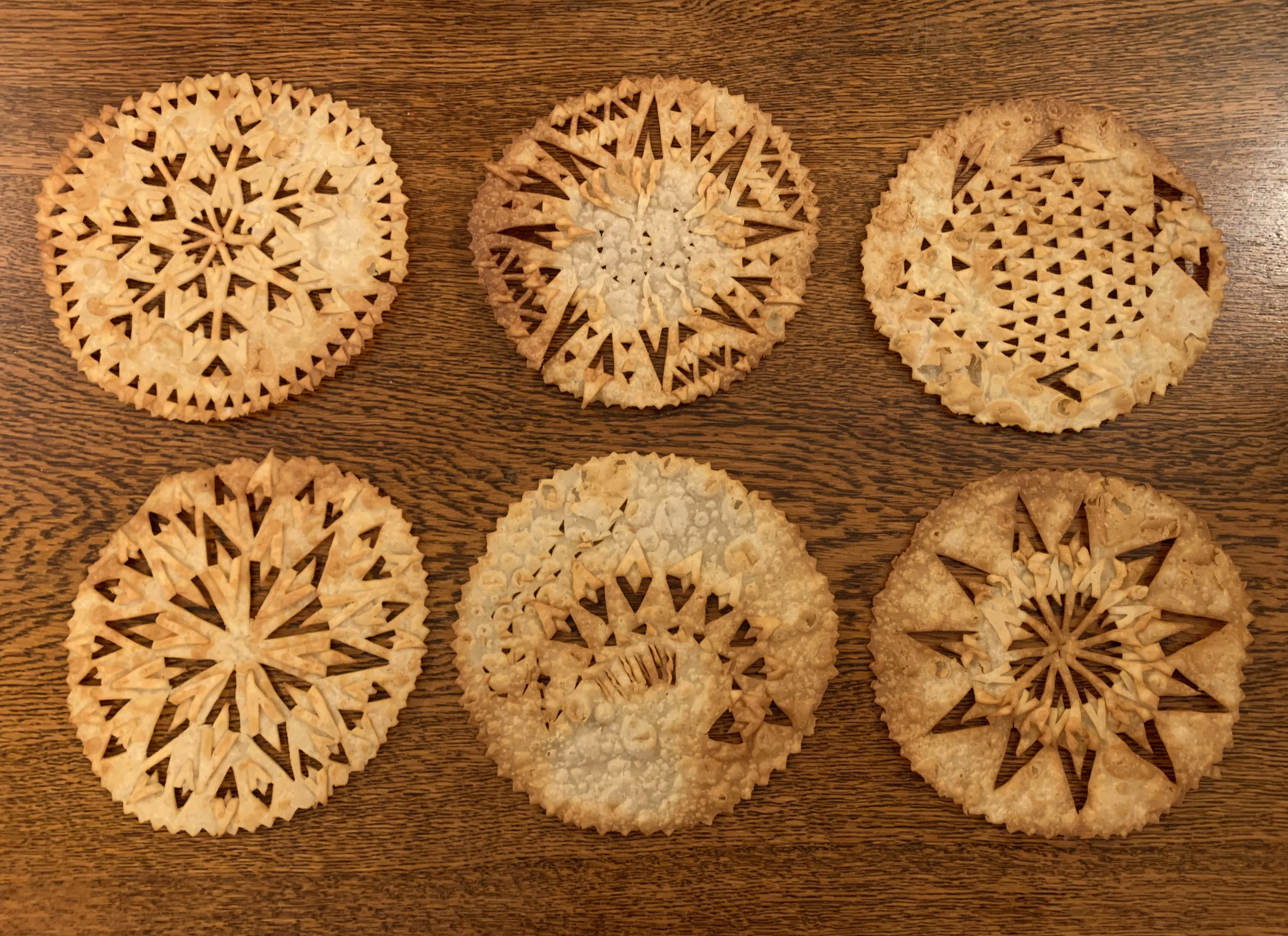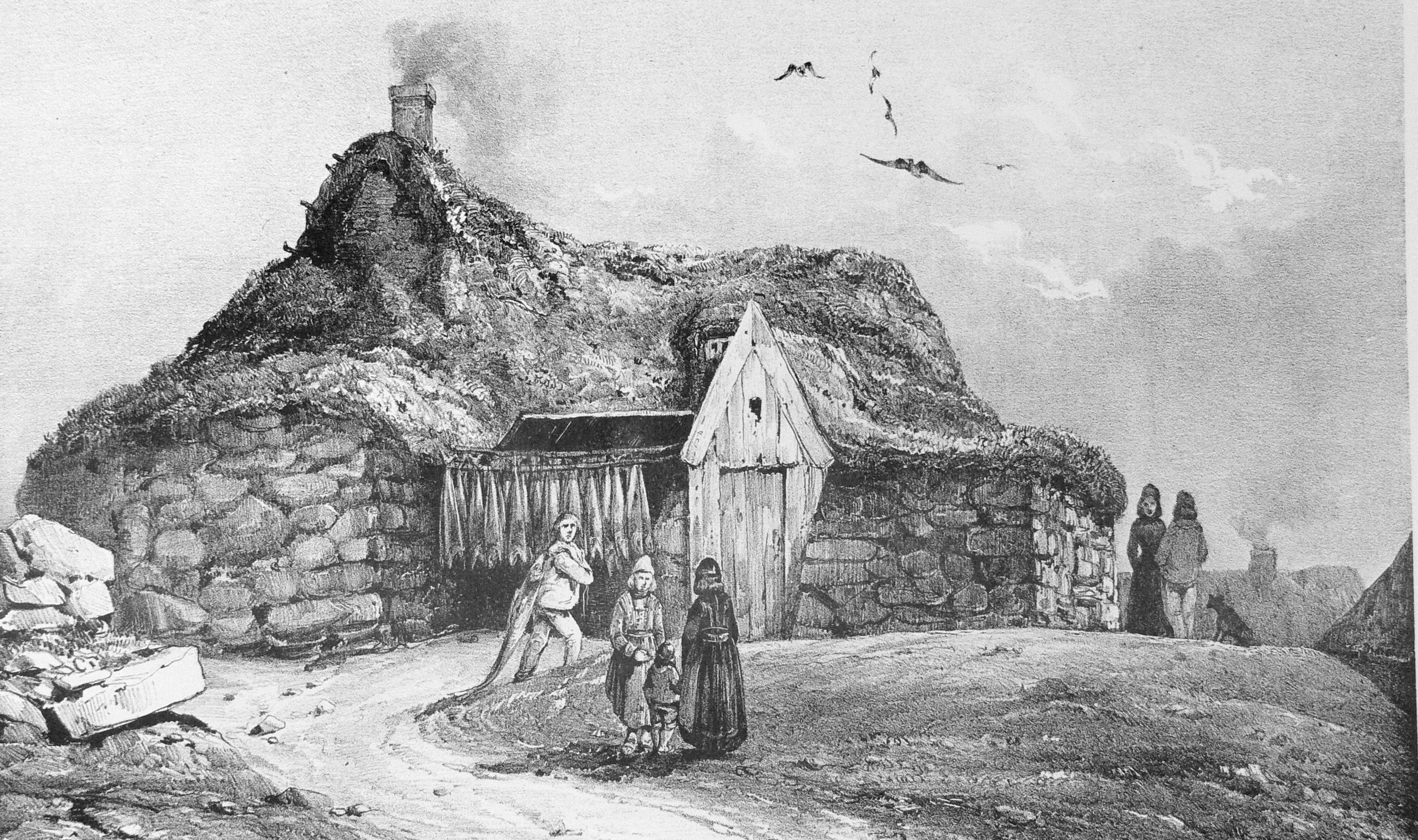|
Laufabrauð
(, "leaf bread"; sometimes also called "snowflake bread" in English) is a traditional kind of Icelandic bread that is most often eaten in the Christmas season. Originating from northern Iceland but now eaten throughout the country, it consists of round, very thin flat cakes with a diameter of about 15 to 20 cm (6 to 8 inches), decorated with leaf-like, geometric patterns and fried briefly in hot fat or oil. can be bought in bakeries or made at home, either with ready-made dough or from scratch; patterns are either cut by hand or created using a heavy brass roller, the ' (, "leaf bread iron"). The most common pattern consists of rows of "V"-like flaps; each flap overlaps with the next one to form a braid A braid (also referred to as a plait) is a complex structure or pattern formed by interlacing two or more strands of flexible material such as textile yarns, wire, or hair. The simplest and most common version is a flat, solid, three-strande ...-like design. The ... [...More Info...] [...Related Items...] OR: [Wikipedia] [Google] [Baidu] |
Icelandic Cuisine
''Randabrauð'', the cuisine of Iceland, has a long history. Important parts of Icelandic cuisine are lamb, dairy, and fish, the latter due to the fact that Iceland has traditionally been inhabited only near its coastline. Popular foods in Iceland include skyr, hangikjöt (smoked lamb), kleinur, laufabrauð, and bollur. Þorramatur is a traditional buffet served at midwinter festivals called Þorrablót; it includes a selection of traditionally cured meat and fish products served with '' rúgbrauð'' (dense dark and sweet rye bread) and brennivín (an Icelandic akvavit). The flavors of this traditional country food originate in its preservation methods; pickling in fermented whey or brine, drying, and smoking. Modern Icelandic chefs usually emphasise the quality of available ingredients rather than age-old cooking traditions and methods. Numerous restaurants in Iceland specialise in seafood. At the annual Food and Fun chef's competition (held since 2004), competitors c ... [...More Info...] [...Related Items...] OR: [Wikipedia] [Google] [Baidu] |
Iceland
Iceland ( is, Ísland; ) is a Nordic island country in the North Atlantic Ocean and in the Arctic Ocean. Iceland is the most sparsely populated country in Europe. Iceland's capital and largest city is Reykjavík, which (along with its surrounding areas) is home to over 65% of the population. Iceland is the biggest part of the Mid-Atlantic Ridge that rises above sea level, and its central volcanic plateau is erupting almost constantly. The interior consists of a plateau characterised by sand and lava fields, mountains, and glaciers, and many glacial rivers flow to the sea through the lowlands. Iceland is warmed by the Gulf Stream and has a temperate climate, despite a high latitude just outside the Arctic Circle. Its high latitude and marine influence keep summers chilly, and most of its islands have a polar climate. According to the ancient manuscript , the settlement of Iceland began in 874 AD when the Norwegian chieftain Ingólfr Arnarson became the first ... [...More Info...] [...Related Items...] OR: [Wikipedia] [Google] [Baidu] |
Flatbread
A flatbread is a bread made with flour; water, milk, yogurt, or other liquid; and salt, and then thoroughly rolled into flattened dough. Many flatbreads are unleavened, although some are leavened, such as pizza and pita bread. Flatbreads range from below one millimeter to a few centimeters thick so that they can be easily eaten without being sliced. They can be baked in an oven, fried in hot oil, grilled over hot coals, cooked on a hot pan, tava, comal, or metal griddle, and eaten fresh or packaged and frozen for later use. History Flatbreads were amongst the earliest processed foods, and evidence of their production has been found at ancient sites in Mesopotamia, ancient Egypt, and the Indus civilization. In 2018, charred bread crumbs were found at a Natufian site called Shubayqa 1 in Jordan (in Harrat ash Shaam, the Black Desert) dating to 12,400 BC, some 4,000 years before the start of agriculture in the region. Analysis showed that they were probably from flatbread ... [...More Info...] [...Related Items...] OR: [Wikipedia] [Google] [Baidu] |
Various Laufabrauð Designs
Various may refer to: * Various (band), an English dubstep/electronic music duo * Various artists, a term for a compilation album containing pieces by various musicians * Various authors, a book containing works by several writers * ''The Various'', a children's fantasy novel by Steve Augarde See also * Various & Gould, a Berlin-based artist duo * ''Various Artists – Archives Vol. 4'', an album by Steve Vai * ''Various Failures'', a compilation album by American experimental rock band Swans * ''The Various Haunts of Men'', a novel by Susan Hill * ''Various Positions'', an album by Leonard Cohen ** Various Positions Tour Various may refer to: * Various (band), an English dubstep/electronic music duo * Various artists, a term for a compilation album containing pieces by various musicians * Various authors, a book containing works by several writers * ''The Various' ... * ''Various Positions'' (film), a 2002 film directed by Ori Kowarsky * Varius (other) * [Baidu] |
En:lauf
{{disambiguation, geo ...
Lauf may refer to: * Lauf an der Pegnitz, town in Bavaria, Germany * Lauf (Baden), municipality in Baden-Württemberg, Germany *Lauf Cycling, an Icelandic cyclocross company See also * Hans Freiherr von Geyer zu Lauf (1895–1959), German painter * ''The Way Things Go'' (German: ''Der Lauf der Dinge''), a 1987 art film by the Swiss artist duo Peter Fischli and David Weiss * Lauff Josef Lauff (16 November 1855 - 1933) was a German poet and dramatist. He was born at Cologne, the son of a jurist. He was educated at Münster in Westphalia, and entering the army served as a lieutenant of artillery at Thorn and subseque ... [...More Info...] [...Related Items...] OR: [Wikipedia] [Google] [Baidu] |
Christmas
Christmas is an annual festival commemorating the birth of Jesus Christ, observed primarily on December 25 as a religious and cultural celebration among billions of people around the world. A feast central to the Christian liturgical year, it is preceded by the season of Advent or the Nativity Fast and initiates the season of Christmastide, which historically in the West lasts twelve days and culminates on Twelfth Night. Christmas Day is a public holiday in many countries, is celebrated religiously by a majority of Christians, as well as culturally by many non-Christians, and forms an integral part of the holiday season organized around it. The traditional Christmas narrative recounted in the New Testament, known as the Nativity of Jesus, says that Jesus was born in Bethlehem, in accordance with messianic prophecies. When Joseph and Mary arrived in the city, the inn had no room and so they were offered a stable where the Christ Child was soon born, with angel ... [...More Info...] [...Related Items...] OR: [Wikipedia] [Google] [Baidu] |
Braid
A braid (also referred to as a plait) is a complex structure or pattern formed by interlacing two or more strands of flexible material such as textile yarns, wire, or hair. The simplest and most common version is a flat, solid, three-stranded structure. More complex patterns can be constructed from an arbitrary number of strands to create a wider range of structures (such as a fishtail braid, a five-stranded braid, rope braid, a French braid and a waterfall braid). The structure is usually long and narrow with each component strand functionally equivalent in zigzagging forward through the overlapping mass of the others. It can be compared with the process of weaving, which usually involves two separate perpendicular groups of strands (warp and weft). Historically, the materials used have depended on the indigenous plants and animals available in the local area. During the Industrial Revolution, mechanized braiding equipment was invented to increase production. The braidin ... [...More Info...] [...Related Items...] OR: [Wikipedia] [Google] [Baidu] |
Iceland Review
''Iceland Review'' is the oldest English-language magazine about Iceland, having originally been published in August 1963. It also runs a news website which covers current events in Iceland. Since 2009, the online version is offered in German as well. The ''Iceland Review'' magazine publishes reports on Icelandic society, politics, pop culture, music, art, literature, current events, as well as interviews with notable Icelanders, articles on traveling in Iceland, and photo essay A photographic essay or photo-essay for short is a form of visual storytelling, a way to present a narrative through a series of images. A photo essay delivers a story using a series of photographs and brings the viewer along a narrative journey. E ...s on Iceland. The magazine is published on a bi-monthly basis. References External links * 1963 establishments in Iceland Cultural magazines English-language magazines Entertainment magazines Magazines established in 1963 Magazines published in ... [...More Info...] [...Related Items...] OR: [Wikipedia] [Google] [Baidu] |
Christmas Food
Christmas is an annual festival commemorating the birth of Jesus Christ, observed primarily on December 25 as a religious and cultural celebration among billions of people around the world. A feast central to the Christian liturgical year, it is preceded by the season of Advent or the Nativity Fast and initiates the season of Christmastide, which historically in the West lasts twelve days and culminates on Twelfth Night. Christmas Day is a public holiday in many countries, is celebrated religiously by a majority of Christians, as well as culturally by many non-Christians, and forms an integral part of the holiday season organized around it. The traditional Christmas narrative recounted in the New Testament, known as the Nativity of Jesus, says that Jesus was born in Bethlehem, in accordance with messianic prophecies. When Joseph and Mary arrived in the city, the inn had no room and so they were offered a stable where the Christ Child was soon born, with angels proclai ... [...More Info...] [...Related Items...] OR: [Wikipedia] [Google] [Baidu] |
Flatbreads
A flatbread is a bread made with flour; water, milk, yogurt, or other liquid; and salt, and then thoroughly rolled into flattened dough. Many flatbreads are unleavened, although some are leavened, such as pizza and pita bread. Flatbreads range from below one millimeter to a few centimeters thick so that they can be easily eaten without being sliced. They can be baked in an oven, fried in hot oil, grilled over hot coals, cooked on a hot pan, tava, comal, or metal griddle, and eaten fresh or packaged and frozen for later use. History Flatbreads were amongst the earliest processed foods, and evidence of their production has been found at ancient sites in Mesopotamia, ancient Egypt, and the Indus civilization. In 2018, charred bread crumbs were found at a Natufian site called Shubayqa 1 in Jordan (in Harrat ash Shaam, the Black Desert) dating to 12,400 BC, some 4,000 years before the start of agriculture in the region. Analysis showed that they were probably from flatbread con ... [...More Info...] [...Related Items...] OR: [Wikipedia] [Google] [Baidu] |



.jpg)

